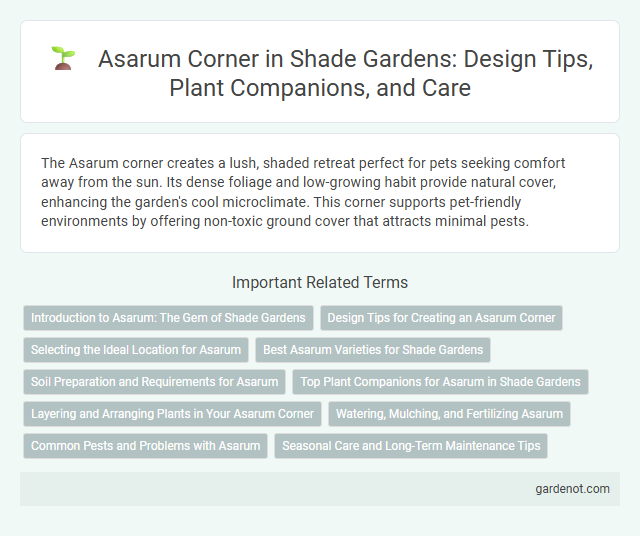The Asarum corner creates a lush, shaded retreat perfect for pets seeking comfort away from the sun. Its dense foliage and low-growing habit provide natural cover, enhancing the garden's cool microclimate. This corner supports pet-friendly environments by offering non-toxic ground cover that attracts minimal pests.
Introduction to Asarum: The Gem of Shade Gardens
Asarum, commonly known as wild ginger, thrives in shaded garden corners with its heart-shaped leaves and low-growing, carpet-like habit. This perennial groundcover is prized for its ability to suppress weeds while adding rich texture and evergreen appeal to shady, moist areas. Its unique, inconspicuous flowers bloom near the soil, making Asarum an essential gem for enhancing biodiversity and visual interest in shade gardens.
Design Tips for Creating an Asarum Corner
Select Asarum species with varying leaf shapes and colors to create textural contrast in the shade garden. Incorporate organic mulch and rich, well-drained soil to maintain moisture and promote healthy growth in the typically humid, low-light environment. Position taller shade plants around the edges to frame the Asarum corner, enhancing visual interest while protecting it from harsh sunlight.
Selecting the Ideal Location for Asarum
Asarum thrives best in shaded, moist environments with well-draining soil rich in organic matter. Choose a location that mimics its natural woodland habitat, such as under deciduous trees or along shaded garden borders. Ensure the spot remains cool and protected from harsh afternoon sun to promote healthy growth and vibrant foliage.
Best Asarum Varieties for Shade Gardens
Asarum, commonly known as wild ginger, thrives in shady garden corners with its heart-shaped leaves and ground-hugging habit. Best Asarum varieties for shade gardens include Asarum europaeum, noted for its glossy evergreen foliage, Asarum canadense with its rich green and maroon leaves, and the striking Asarum splendens featuring silver-patterned leaves that brighten dark areas. These varieties provide excellent ground cover, suppress weeds, and add texture to low-light garden spaces.
Soil Preparation and Requirements for Asarum
Asarum thrives in well-drained, humus-rich soil with a slightly acidic to neutral pH between 5.5 and 7.0, mimicking its natural woodland habitat. Incorporating organic matter such as leaf mold, compost, or well-rotted manure enhances soil fertility and moisture retention, essential for healthy growth. Ensuring consistently moist, but not waterlogged, soil conditions helps prevent root rot and supports the plant's spreading rhizomes in shaded garden corners.
Top Plant Companions for Asarum in Shade Gardens
Top plant companions for Asarum in shade gardens include hostas, ferns, and Heuchera, which share similar moisture and light requirements. These plants complement Asarum's low-growing, ground-cover habit while enhancing the garden's texture and color variety. Selecting companions with contrasting leaf shapes and colors, such as the textured fronds of ferns or the vibrant foliage of Heuchera, creates a visually appealing and thriving shade garden ecosystem.
Layering and Arranging Plants in Your Asarum Corner
Layering and arranging plants in your Asarum corner enhances its natural woodland aesthetic by combining diverse textures and heights. Utilize Asarum's low-growing, heart-shaped leaves as a dense groundcover beneath taller shade plants like ferns and hostas to create depth and visual interest. Incorporating varying foliage colors and seasonal blooms ensures year-round appeal and promotes a healthy, balanced shade garden ecosystem.
Watering, Mulching, and Fertilizing Asarum
Watering Asarum requires maintaining consistently moist soil without waterlogging to promote healthy root growth in shady garden corners. Applying a 2-3 inch layer of organic mulch such as shredded leaves or bark helps retain soil moisture, regulate temperature, and suppress weeds around Asarum plants. Fertilize lightly in early spring with a balanced, slow-release fertilizer to support robust foliage and encourage vibrant ground cover development.
Common Pests and Problems with Asarum
Asarum, commonly known as wild ginger, is susceptible to slug and snail damage, which can severely affect its foliage in shade gardens. Rhizome rot caused by poorly drained soil and fungal infections often leads to plant decline, necessitating well-drained, moist conditions to prevent these issues. Regular monitoring and organic pest control methods are essential to maintain healthy Asarum growth and vibrant ground cover.
Seasonal Care and Long-Term Maintenance Tips
Asarum corners thrive in consistently moist, well-drained soil enriched with organic matter to support year-round growth. Seasonal care includes mulching in fall to protect roots from winter cold and foliage pruning in early spring to remove old growth and promote fresh shoots. Long-term maintenance involves monitoring soil acidity, ensuring partial to full shade exposure, and dividing clumps every 3-4 years to prevent overcrowding and sustain vigorous plant health.
Asarum corner Infographic

 gardenot.com
gardenot.com